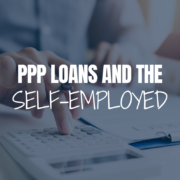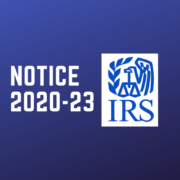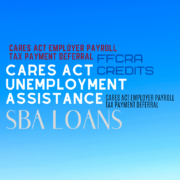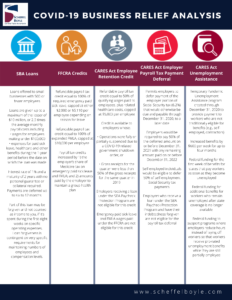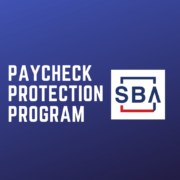PPP Loans and the Self-Employed: Schedule C and Schedule F
SBA issued an Interim Final Rule regarding the Paycheck Protection Program as it relates to the self-employed filing a Schedule C this week. Below is a summary of the guidance and we have also linked a copy of the Interim Final Rule here for reference.
Individuals with Self-Employment Income who File a Form 1040, Schedule C
You are eligible for a PPP Loan if:
- You were in operation on February 15, 2020.
- You are an individual with self-employment income (such as an independent contractor or sole proprietor)
- Your principal place of residence is in the US
- You filed or will file a Form 1040 Schedule C for 2019.
How to calculate the maximum amount of loan (businesses without employees):
Step 1: Find the 2019 Form 1040 Schedule C line 31 net profit amount (if you have not yet filed a 2019 return, fill it out and compute the value). If this amount is over $100,000, reduce it to $100,000. If this amount is zero or less, you are not eligible for a PPP loan.
Step 2: Calculate the average monthly net profit amount (divide the amount from Step 1 by 12)
Step 3: Multiply the average monthly net profit amount from Step 2 by 2.5
Step 4: Add the outstanding amount of any Economic Injury Disaster Loan made between 1/31/20 to 4/3/20 that you seek to refi.
The applicant must provide the 2019 Form 1040 Schedule C, 2019 1099-MISC showing non-employee comp, invoice, bank statements or books of record that establishes they are self-employed. Applicants must also provide a 2020 income invoice, bank statement, or book of record to establish they were in operation on or around 2/15/20.
How to calculate the maximum amount of loan (businesses with employees):
Step 1:
- Find the 2019 Form 1040 Schedule C line 31 net profit amount (if you have not yet filed a 2019 return, fill it out and compute the value). If this amount is over $100,000, reduce it to $100,000. If this amount is zero or less, set this amount at zero.
- 2019 gross wages and tips paid to your employees using 2019 Form 941 taxable Medicare wages and tips from each quarter plus any pre-tax employee contributions for health insurance or other fringe benefits excluded from taxable Medicare wages and tips; subtract any amounts paid to any individual employee in excess of $100,000 annualized.
- 2019 employer health insurance contributions (health insurance component of Schedule C line 14), retirement contributions (Schedule C line 19), and state and local taxes assessed on employee compensation (state unemployment). Note that owner self-employed health insurance and owner retirement contributions deducted on Schedule 1 are NOT factored into the calculation.
Step 2: Calculate the average monthly amount (divide the amount from Step 1 by 12)
Step 3: Multiply the average monthly amount from Step 2 by 2.5
Step 4: Add the outstanding amount of any Economic Injury Disaster Loan made between 1/31/20 to 4/3/20 that you seek to refi
Applicant must provide 2019 Form 1040 Schedule C and Form 941’s and evidence supporting the health insurance and retirement contributions.
The Proceeds of the PPP loan are to be used for the following:
- Owner compensation replacement, calculated based on 2019 net profit as described above.
- Employee payroll costs (as described in first Interim Final Rule)
- Mortgage interest payments on any business mortgage obligation on real or personal property (NOTE: this is what the rule says but there is no such thing as a mortgage on personal property)
- Interest payments on any other debt obligations that were incurred before 2/15/20 but such amounts are not eligible for PPP loan forgiveness.
- Rent and Utilities
The use of loan proceeds is limited to those types of allowable uses for which the borrower made expenditures in 2019. So, if the expense was not there in 2019 but is an expense for 2020, it may not be used.
What amounts shall be eligible for forgiveness:
- Payroll costs including salary, wages and tips up to $100,000 of annualized pay per employee (for eight weeks, a maximum of $15,385 per individual) as well as covered benefits for employees (but not owners).
- Owner compensation replacement calculated based on 2019 net profits as described above, with forgiveness of such amounts limited to eight weeks’ worth (8/52) of 2019 net profit.
- Payments of interest on mortgage obligations on real or personal property incurred before 2/15/20 to the extent deductible on Schedule C
- Rent payments on lease agreements in force before 2/15/20 to the extent deductible on Schedule C and utility payments under service agreements dated before 2/15/20.
75% of the amount forgiven must be attributable to payroll costs.
Other items to note in this new guidance:
- If the individual is a partner in a partnership, they may not submit a separate PPP loan application for themselves as a self-employed individual. (This pertains to the PPP for the partnership, the individual may apply as self-employed if they have a separate Schedule C)
- Instead, the self-employment income of general active partners may be reported as payroll costs, up to $100,000 annualized on a PPP loan application filed by or on behalf of the partnership.
- SBA will issue additional guidance for those individuals with self-employment income who are:
- Not in operation in 2019 but who were in operation on 2/15/20, and
- Will file of Schedule C for 2020
Individuals with Self-Employment Income who File a Form 1040, Schedule F
In this Guidance issued on April 14th, it refers to Schedule C’s and not Schedule F. Farmers tend to incur more gains on the sale of equipment reported on Form 4797 that is not reported on Schedule F. Therefore, we may see additional guidance from SBA or perhaps the USDA if the PPP loan is calculated on “net farm income”, including these gains or on “net self-employment” income without these gains.
Please reach out to our team if you have questions on this new development. We are always here to help.

